Hardware and Stamping Mold Parts
Hardware and Stamping Mold Parts
Blog Article
Hardware and Stamping Mold Parts are key tools for manufacturing hardware parts and products. Metal materials (such as steel, aluminum, copper, etc.) are processed into the required shape and size through the stamping process. Stamping mold parts are usually composed of multiple precision components to help complete processes such as cutting, bending, strEtching, punching, etc. They are widely used in industries such as automobiles, electronics, home appliances, aviation, and medical.

Processing accuracy
The processing accuracy of stamping mold parts is usually very high, especially when manufacturing complex shapes and high-precision parts.
Tolerance range: Generally, it can reach ±0.01mm to ±0.05mm, and for some high-precision molds, the tolerance can be smaller.
Surface roughness: The common surface roughness is Ra 0.8-3.2μm, and for some high-demand parts, the surface roughness can reach Ra 0.4μm.
Positioning accuracy: The positioning accuracy of mold parts is crucial to production consistency, and the positioning tolerance is usually controlled within 0.05mm.
Die life
Die life is an important indicator of die durability, which usually depends on the quality, design, processing accuracy and working conditions of the die material.
Life estimation: The life of a standard die is usually between 100,000 and 1,000,000 stampings.
High-durability die: The use of highly wear-resistant materials such as high-speed steel (HSS) or carbide can increase die life and extend the service life to More than 3 million times.
Influencing factors: Die life is affected by many factors, including stamping material type, stamping speed, die cooling system, lubrication conditions, etc.
Die design
Die design is the key to ensuring efficient and stable stamping process. The complexity of stamping parts, material properties, production efficiency and die maintenance factors need to be considered during design.
Die type: Common stamping die designs include single-process die, composite die, progressive die, drawing die, etc.
Design accuracy: The accuracy of die design requires matching the accuracy of the produced parts, and the die design tolerance is usually controlled within ±0.01mm.
Mold structure: Mold design should consider mechanical properties, cooling system, waste discharge system, lubrication system, etc. to ensure that the mold will not wear out prematurely during long-term use.
Design software: Modern mold design generally uses CAD/CAM/CAE software for 3D modeling and simulation analysis to ensure the efficiency and accuracy of the design.
Hardware and stamping mold parts provide high-precision and high-efficiency production capabilities through Precision Machining and design. The mold life can usually reach 100,000 to 1 million times depending on the material and process conditions, and the mold design needs to comprehensively consider the cost and production efficiency while ensuring the stamping accuracy. By continuously improving the design and material selection, the working efficiency and service life of the mold can be significantly improved.